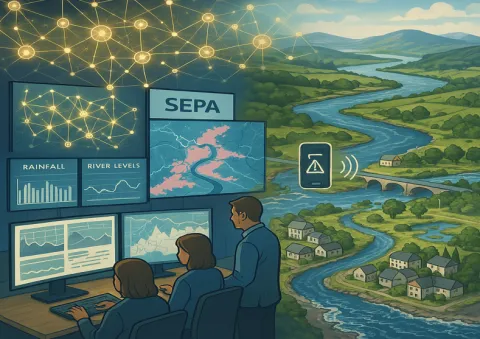
Flooding is one of the most serious climate-related risks facing Scotland, with events expected to become more frequent and severe. The Scottish Environment Protection Agency (SEPA) plays a vital role in forecasting floods, issuing warnings, and helping communities prepare. Exciting new research led by the University of Strathclyde and funded by CREW explored how cutting-edge technologies could strengthen these efforts.
The project critically reviewed how Artificial Intelligence and Machine Learning could be used to improve flood forecasting in Scotland. The research team examined the latest academic research and real-world applications, brought together international experts, and assessed how feasible it would be to integrate Artificial Intelligence and Machine Learning into SEPA’s existing flood forecasting systems.
Artificial Intelligence and Machine Learning technologies can analyse vast datasets, spot hidden patterns, and provide real-time predictions. They could help SEPA deliver more accurate warnings, optimise emergency responses, and improve local monitoring in areas with limited data. However, the researchers found that, while Artificial Intelligence is advancing quickly, most real-world systems still combine Artificial Intelligence with traditional forecasting methods, with human judgement remaining central. Trust, transparency, and high-quality data are essential for responsible use.
The study recommends a phased approach. In the short term, SEPA could focus on high-impact, low-effort applications, such as improving early warnings and decision support. Over the next three to five years, more advanced applications, including enhanced weather inputs, local monitoring, and model calibration, could be trialled. Training and upskilling forecasters will also be key to building confidence in Artificial Intelligence assisted forecasting.
CREW would like to thank the research team (University of Strathclyde) and the Project Steering Group (SEPA, Environment Agency, and Scottish Government) for their dedication and support to the project and in addressing this important issue.